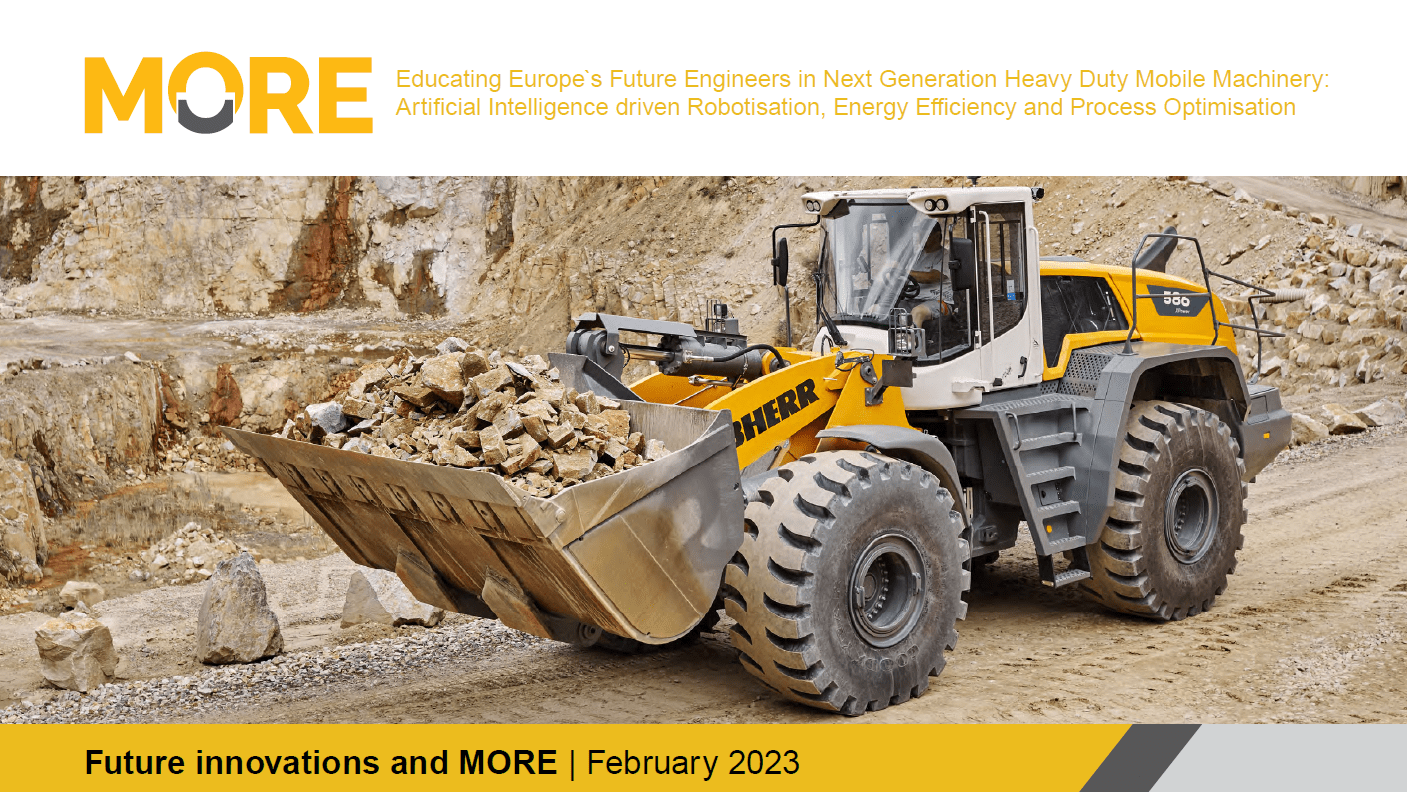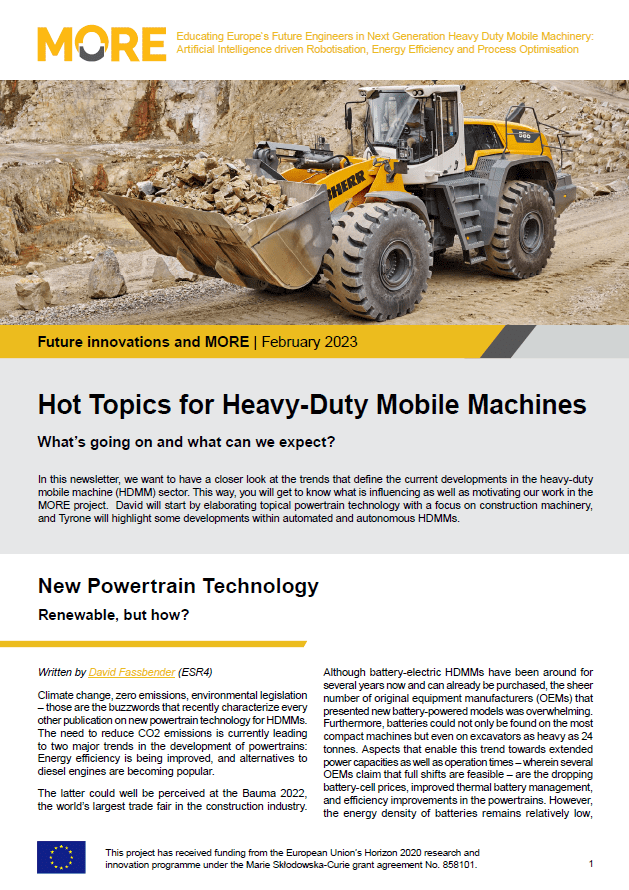
Hot Topics for Heavy-Duty Mobile Machines
What’s going on and what can we expect?
In this newsletter, we want to have a closer look at the trends that define the current developments in the heavy-duty mobile machine (HDMM) sector. This way, you will get to know what is influencing as well as motivating our work in the MORE project. David will start by elaborating topical powertrain technology with a focus on construction machinery, and Tyrone will highlight some developments within automated and autonomous HDMMs.
Articles
- New Powertrain Technology
Renewable, but how? - The Road Towards Autonomous Heavy-Duty Mobile Machinery
Be Prepared for a Few Bumps Along the Way
New Powertrain Technology
Renewable, but how?
Climate change, zero emissions, environmental legislation – those are the buzzwords that recently characterize every other publication on new powertrain technology for HDMMs. The need to reduce CO2 emissions is currently leading to two major trends in the development of powertrains: Energy efficiency is being improved, and alternatives to diesel engines are becoming popular.
The latter could well be perceived at the Bauma 2022, the world’s largest trade fair in the construction industry. Although battery-electric HDMMs have been around for several years now and can already be purchased, the sheer number of original equipment manufacturers (OEMs) that presented new battery-powered models was overwhelming. Furthermore, batteries could not only be found on the most compact machines but even on excavators as heavy as 24 tonnes. Aspects that enable this trend towards extended power capacities as well as operation times – wherein several OEMs claim that full shifts are feasible – are the dropping battery-cell prices, improved thermal battery management, and efficiency improvements in the powertrains. However, the energy density of batteries remains relatively low, and other alternatives can be found especially for the weight classes way beyond 10 tonnes. If possible, grid connections are established through cables or overhead lines – potentially in combination with batteries that can be more easily charged this way. Otherwise, hydrogen is the keyword. It can be used for hydrogenation of vegetable oils, which can be used in conventional combustion engines; direct combustion in engines that are optimized for hydrogen is possible; or hydrogen is used in fuel cells to provide electric power. Prototypes for all those options were presented at Bauma, but the more critical aspect seems to be the basically nonexistent hydrogen infrastructure and not the powertrain technology. On the other hand, providing enough electric power from renewable sources at any time for the majority of HDMMs would be challenging as well, and an approach that involves green hydrogen made from electricity as a storable form of energy will most likely be the only feasible solution.
In this regard, an improved energy efficiency can be a powerful enabler. It lowers the energy demand, not only for the energy storage on the HDMM but also for the power plants and electric grid in the first place. One solution that goes hand in hand with using batteries or fuel cells, which provide electric energy, is to switch from hydraulic drives to highly efficient pure electro-mechanical actuation. For rotational movement, meaning especially the drivetrains, this is common practice for electrified HDMMs. However, there are certain arguments such as robustness, compactness, and costs that also lead to hydraulic solutions remaining in place. This is especially true for linear actuation, which can be realized in a very compact and cost-efficient way even for extremely high forces and for a very high number of actuators when hydraulics is used. Still, a first generation of entirely non-hydraulic demonstrators can be found, which even have the hydraulic cylinders replaced by electro-mechanical spindles. Those machines are characterized by only a small number of low-power actuators and significant benefits from oil-free operation – a combination for which non hydraulic powertrains might become more common in the future. Anyways, several applications will remain for hydraulics, and more efficient hydraulic concepts must be found. However, there is no major trend noticeable in this regard so far.
All in all, the development of HDMM power trains is recently very dynamic and focused on reducing emissions. Furthermore, the technological diversity is increasing, which is not surprising since the group of HDMMs is very diverse itself and a one-fits-all solution – like the diesel engine in combination with hydraulics might have been in the past– is unlikely to be found in the near future.

About the author
David Fassbender
Early Stage Researcher 4
David is a 3rd year Ph.D. researcher and working on electrified hydraulic systems for mobile machines. In his studies, he focuses on how to obtain more efficient concepts while valuing other success factors such as cost effectiveness as well.
The Road Towards Autonomous Heavy-Duty Mobile Machinery
Be Prepared for a Few Bumps Along the Way
According to the UN, the world population exceeded 8 billion people in 2022. Yet, the HDMM industry faces a shortage of skilled operators, further compounded by aging populations in regions like Europe. Moreover, dangerous accidents involving HDMMs are not uncommon while recent crises such as armed conflicts, Covid-19 pandemic, and supply chain shortages have increased the cost pressures in the HDMM industry. To address such macroeconomic and societal trends, highly automated and autonomous HDMMs, which require minimal human oversight and offer predictable outcomes, are envisioned to be a viable future solution in vital application areas of HDMMs such as construction, mining, agriculture, and logistics.
It may come as a surprise to many that autonomous HDMMs, notably haul/dump trucks, have been operational in mines for more than a decade already. Despite these early developments, standardized definitions for different Levels of Automation (LOA) are still missing in the HDMM industry. Hence, what an automated HDMM is, and its associated capabilities can be easily misunderstood, more so while using the term “autonomous” to describe HDMMs that do not satisfy the requirements for autonomy. Thus, several efforts are underway to define standard taxonomies for LOA specific to HDMMs, for example, ISO/AWI 7334 [1], ‘Connected and Autonomous Plant – Autonomous Capability Framework’ by TRL UK [2], and the LOA Matrix [3]. Accordingly, HDMMs can be classified as manual/no automation, operator assistance systems, semi-autonomous systems with humans still in the loop, or autonomous systems without any direct human control. Operator assistance systems which aid and assist the HDMM operator in being more productive were marketed by several suppliers and OEMs alike at Bauma 2022. These assistance systems can either be retrofitted as add-on solutions such as machine guidance and machine control systems or provided as turnkey solutions by the OEMs. Increasing the LOA beyond operator assistance systems, such as for fully autonomous systems, increases the associated costs as well as efforts, for example, due to the need for perception sensors (Lidar, Radar, cameras, etc.), high-performance computing, and software development cycles. Thus, semi-autonomous systems, wherein one human operator remotely monitors or teleoperates one or more HDMMs, are being considered as a more feasible solution. This was also perceivable at Bauma 2022.
Currently, fully autonomous systems may be too expensive and require significant development and deployment efforts to reap operational benefits, especially in areas with unstructured environments, such as construction sites. Since the HDMM industry has its roots in traditional mechanical engineering, it is important for the HDMM industry to develop complementary skills and competences in fields such as robotics, artificial intelligence, and software engineering. Quite often, automated and/or autonomous HDMM proofs of concepts only address a narrow range of tasks on a worksite. However, HDMMs such as excavators and front loaders can be used in a versatile manner for a broad range of tasks. Thus, addressing process automation rather than HDMM automation is the key towards enabling fully autonomous HDMMs.
Moreover, certain organizations deploy generalized solutions onto the end-user’s mixed fleets consisting of different HDMMs from several OEMs. These are known as OEM agnostic solutions, wherein a third-party retrofits automation solutions onto an HDMM of any OEM. Accordingly, multidisciplinary and collaborative partnerships have become increasingly important for the deployment of automated HDMMs, especially between OEMs, add-on solution providers, and end-user groups. Moreover, the automation of HDMMs goes hand in hand with other developments such as digitalization, energy transition, and circular economy. Therefore, services like telematics, condition monitoring, information automation, digitalization of data, and improved network connectivity enable new business models and revenue streams arising from the use of automated and autonomous HDMMs, for example, by using Product as a Service. However, these new business models are still in their nascent stages.
Currently, the Americas and Australia are frontrunners in the deployment of highly automated HDMMs. Several pilot projects and collaborative partnerships between different OEMs and end-user groups are ongoing in Europe. Thus, the road towards autonomous HDMMs is currently being paved, but do expect some bumps of different sizes along the way. Stricter legislative requirements as well as legislative uncertainty towards the operation of automated HDMMs in the EU pose a barrier to the successful deployment of highly automated HDMMs. Thus, while we may see individual HDMMs enabled with high LOA for very specific tasks, an autonomous worksite operating with truly autonomous HDMMs still has a long way to go. Standardization of process and definitions could even out several, but not all the bumps, and require the HDMM industry to work collaboratively.
References
[1] https://www.iso.org/standard/82754.html
[3] https://trepo.tuni.fi/handle/10024/137129
About the author
Tyrone J. Machado
Early Stage Researcher 1
Tyrone is a 3rd year Ph.D. researcher working on business cases for robotization, artificial intelligence, and process efficiency of heavy-duty machinery. He focusses on automated and autonomous HDMMs, especially from the perspective of developing new business models such as Product as a Service and business ecosystems.


